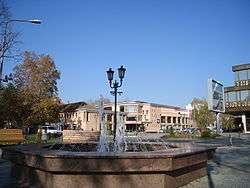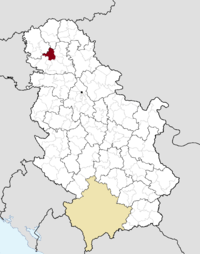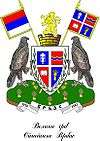Vrbas, Serbia
| Vrbas Врбас | |||
|---|---|---|---|
| Municipality and Town | |||
 | |||
| |||
 Location of the municipality of Vrbas within Serbia | |||
| Coordinates: 45°34′N 19°39′E / 45.567°N 19.650°ECoordinates: 45°34′N 19°39′E / 45.567°N 19.650°E | |||
| Country | Serbia | ||
| Province | Vojvodina | ||
| District | South Bačka | ||
| Settlements | 7 | ||
| Government | |||
| • Mayor | Željko Vidović | ||
| Area[1] | |||
| • Municipality | 376 km2 (145 sq mi) | ||
| Population (2011 census)[2] | |||
| • Town | 24,112 | ||
| • Municipality | 42,092 | ||
| Time zone | CET (UTC+1) | ||
| • Summer (DST) | CEST (UTC+2) | ||
| Postal code | 21460 | ||
| Area code | +381 21 | ||
| Car plates | VS | ||
| Website |
www | ||
Vrbas (Serbian Cyrillic: Врбас), Hungarian: Verbász is a city and municipality located in Serbia at 45°34′N 19°39′E / 45.57°N 19.65°E, in the South Bačka District in the autonomous province of Vojvodina. In 2011 the city had a total population of 24,112, while the municipality had 42,092.
Name
Its name stems from the word "Willow" in the Serbian language. During the SFRY period, the town was renamed Titov Vrbas (meaning "the Vrbas of Tito"), after Josip Broz Tito. Like all other towns in Socialist Yugoslavia named after Tito, the first part was dropped once the new states were formed during the early 1990s.
In Rusyn, the town is known as Вербас, in Hungarian as Verbász, in Croatian as Vrbas, in German as Werbass, and in Turkish as Verbas.
History

Vrbas was mentioned first in 1213 during the administration of the Kingdom of Hungary. According to other sources, it was mentioned first in 1387.[3] In the 16th century it became a part of the Ottoman Empire. During Ottoman administration it was populated by ethnic Serbs.[4]
Since the Treaty of Passarowitz (1718), Vrbas and the Banat were placed under administration of the Habsburg Monarchy. According to the 1720 census, it was populated exclusively by Serbs (about 250 families[5]).[6]
After 1784 many Germans settled in the town founding a new settlement named Novi Vrbas (Neu-Verbasz) near the old Serb settlement, which then became known as Stari Vrbas (Old Vrbas).
In 1910, population of Novi Vrbas was mostly composed of ethnic Germans, while population of Stari Vrbas was ethnically mixed and was mainly composed of Serbs and Germans.[7]
In 1918, Vrbas became part of the Kingdom of Serbs, Croats and Slovenes, which was later renamed to Yugoslavia. The town was under Axis occupation in 1941-1944, and during that time it was attached to Horthy's Hungary. As a consequence of the World War II events in Yugoslavia, the German population fled from the town after this war. In the same time, many settlers from Montenegro came to Vrbas and other neighboring places.
Inhabited places
Vrbas municipality includes the city of Vrbas and the following villages:
Demographics (2011 census)




Ethnic groups in the Vrbas municipality
According to the 2011 census the municipality of Vrbas had a total population of 42,092, including:[8]
- Serbs 23,251 (55.24%)
- Montenegrins 7,353 (17.47%)
- Rusyns 3,375 (8.02%)
- Hungarians 2,464 (5.85%)
- Ukrainians 836 (1.99%)
- Croats 549 (1.30%)
Settlements by ethnic majority
Settlements with Serb ethnic majority are: Bačko Dobro Polje, Zmajevo, Kosančić, Ravno Selo and Vrbas. Ethnically mixed settlements are: Kucura (with relative Rusyn majority) and Savino Selo (with relative Montenegrin majority).
Ethnic groups in the Vrbas town
- Serbs (41.19%)
- Montenegrins (30.05%)
- Hungarians (7.73%)
- Rusyns (5.71%)
- Ukrainians (2.88%)
- Yugoslavs (2.04%)
- Croats (1.65%)
Languages in the Vrbas municipality
According to the 2002 census, 85% of inhabitants of the Vrbas municipality speak Serbian as mother tongue. Other spoken languages include Rusyn (8%), Hungarian (4%) and Ukrainian (1%).
Historical population of the town
- 1961: 19,316
- 1971: 22,496
- 1981: 25,143
- 1991: 25,858
- 2011: 23,910
Politics
Seats in the municipal parliament won in the 2004 local elections:
- Serbian Radical Party (14)
- Democratic Party (9)
- Socialist Party of Serbia (4)
- People's Democratic Party (2)
- Democratic Party of Serbia (2)
- New Social Democracy of Vojvodina (2)
- Strength of Serbia Movement (2)
- G17 Plus (1)
Notable citizens
- Milenko A. Perovic, philosopher
- Nikola Komazec, footballer
- Radoman Božović, politician and former Prime Minister of Serbia from 1991 to 1993.
- Ljubomir Fejsa, professional football player and member of the Serbia national football team
- Molter Károly, writer
- Vladimir Kolarić, Serb and member of the band Veliki Prezir.
- Milan Komnenić, Serbian poet.
- Igor Marojević, Serbian writer
- Vida Ognjenović, writer and director.
- Jozef Pehan, Hungarian painter.
- Mitar Pešikan, Serbian linguist.
- Janko Benša, athletics.
- Desanka Pešut, Serbian sports shooter, World and European champion
- Dragan Momić, former professional handball player.
- Lazar Ristovski, actor.
- Nenad Njaradi, athletics.
- Magdolna Rúzsa, female singer who won Megasztár in 2006.
- Sava Vukoslavović, Serbian ethnomusicologist and composer.
- Milorad Mažić, football referee.
- Johannes Weidenheim, German writer who was born in Vrbas.
- Svetozar Šapurić, former footballer
- Slobodan Vuković, footballer
- Viktor Ország, former footballer
- Bianka Buša, volleyball player and silver medalist at the 2016 Summer Olympics
 The Calvinist church.
The Calvinist church. The Evangelical church.
The Evangelical church. The Immaculate Conception of Blessed Virgin Mary Catholic Church.
The Immaculate Conception of Blessed Virgin Mary Catholic Church. The Methodist church.
The Methodist church.
See also
- Municipalities of Serbia
- South Bačka District
- Bačka
- List of places in Serbia
- List of cities, towns and villages in Vojvodina
References
- Slobodan Ćurčić, Broj stanovnika Vojvodine, Novi Sad, 1996.
- ↑ "Municipalities of Serbia, 2006". Statistical Office of Serbia. Retrieved 2010-11-28.
- ↑ "2011 Census of Population, Households and Dwellings in the Republic of Serbia: Comparative Overview of the Number of Population in 1948, 1953, 1961, 1971, 1981, 1991, 2002 and 2011, Data by settlements" (PDF). Statistical Office of Republic Of Serbia, Belgrade. 2014. ISBN 978-86-6161-109-4. Retrieved 2014-06-27.
- ↑ Dr Slobodan Ćurčić, Naselja Bačke - geografske karakteristike, Novi Sad, 2007, page 220.
- ↑ Dr Slobodan Ćurčić, Naselja Bačke - geografske karakteristike, Novi Sad, 2007, page 220.
- ↑ Dr Slobodan Ćurčić, Naselja Bačke - geografske karakteristike, Novi Sad, 2007, page 220.
- ↑ Ivan Jakšić, Iz popisa stanovništva Ugarske početkom XVIII veka, Novi Sad, 1966.
- ↑ http://img190.imageshack.us/img190/3899/vojvodina1910.png
- ↑ "Population by ethnicity – Vrbas". Statistical Office of the Republic of Serbia (SORS). Retrieved 11 March 2013.
External links
| Wikimedia Commons has media related to Vrbas. |



